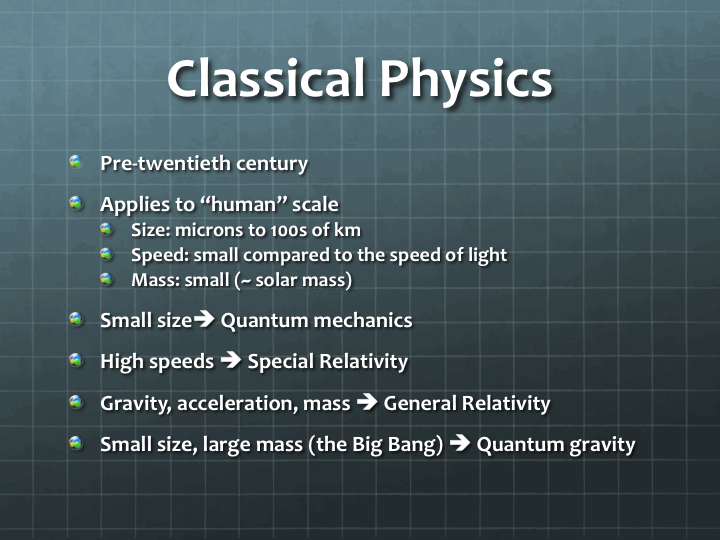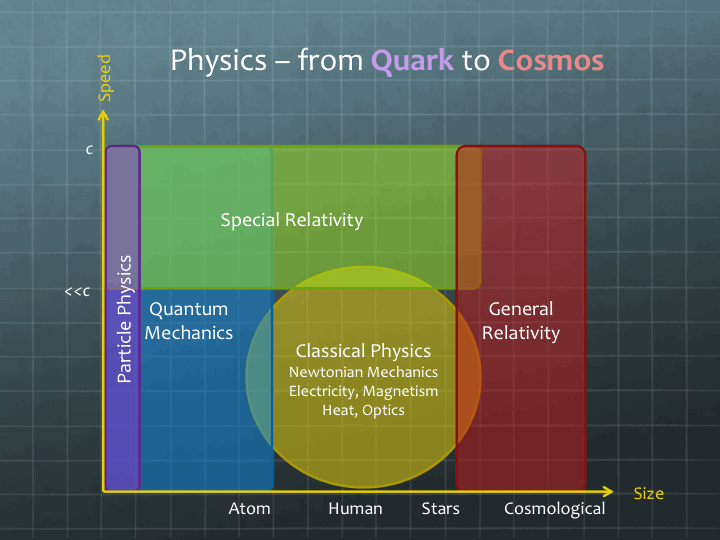The main difficulty in describing particle physics to general public is the fact that it is built on modern physics. Even if you are physics aficionado and did extremely well in your high school physics, what you have learned and loved is classical physics. The difference between classical physics and modern physics is not just more physics, but a completely new way of looking at the reality around us.

Let’s first take a look at classical physics. It was born when Sir Isaac Newton wrote down his equations of motion and the law of gravitation. It expanded through the next couple of centuries with sensible theories of heat, electricity and magnetism, thermodynamics etc. This is the physics that we learn through our high school years.
Physics Completed
By the end of the 19th century, our knowledge of the structure of matter looked more or less complete – so much so that smart people were actually discouraged from joining this dead field of theoretical physics. Indeed, there were some loose ends – like radioactivity, subatomic structure etc., but they were expected to be minor extensions of the theories that enjoyed currency at that point in time.
Little did they know – that in the first 20 years of the 20th century, physics would look so hopelessly incomplete. The revolution that happened during those years is the backdrop of modern physics and particle physics.
Before getting into modern physics, and why it was needed, we need to set the boundaries of what classical physics is. It is the physics of things we can see or imagine. It describes and (even explains in terms of simple or general laws) the behavior of this of human scale. The term “human scale” is vague and deeply unscientific, but it is a fairly generous bracket of lengths, speeds and masses. It will easily encompass anything from a microbe to a planet in size (from microns to thousands of km in length). The bracket in speed will easily include the fastest object we are likely to encounter, such as the fastest meteorite that was clocked at over 100,000 km/h. Of course, I am ignoring the particles (and light itself) that we are bombarded with all the time – classical physics cannot handle those. But it can handle even the largest object, like our planets and even the sun, very nicely.
In fact, classical physics has been spectacular in describing almost everything we knew until the turn of the 20th century. It includes everything that you learned in physics through high school.
- Motion of bodies
- Gravitation, planetary motion
- Heat, optics, sound, waves etc.
- Electricity and magnetism
The definition if classical physics is a bit vague – depending on the context, it may or may not include relativity. In my definition in this article, it doesn’t.
Inconvenient Discoveries
Circa 1900, classical physics had a few issues. It could not describe certain phenomena, and certain discoveries. Here is a short list:
- Radioactivity, alpha, beta, gamma radiations, x-rays.
- Michelson-Morley experiment (absence of ether)
- Discovery of electron
- Black body radiation
- Photoelectric effect
Some of these discoveries (radioactivity, electron) indicated that atoms were not the smallest unit; they were not indivisible or “uncuttable.” The inability to describe some of the other phenomena demonstrated the inadequacy of classical physics. Particles just refuse to behave the way little tiny balls of matter were expected to. And space and light seem to have a very strange relationship.
The Remit of Physics

As we know, the call of physics, its remit, or its domain of applicability is everything – from subatomic, fundamental particles to the whole cosmos; from massless particles to super massive black holes. These vast ranges of size, mass and speed are well beyond what we called human scales.
In Figure 4, I have drawn a pictorial representation of what kind of physics we need to apply when we go beyond human scales. On the x-axis we have size or scale, on the y-axis, the speed.
- Classical physics handles phenomena in the human realm, shown in the yellow circle.
- Quantum Mechanics deals with small (subatomic) objects. Some people interpret it as a measurement problem.
- Special Relativity handles objects in high (but constant) speed motion with respect to each other. Some people (mainly me) think of it as a perceptual effect.
- General Relativity to deal with massive objects, the universe as a whole.
- Quantum gravity to deal with the Big Bang or black holes.
- High Energy Particle Physics falls in the narrow purple region, well away from classical physics.
In order to understand particle physics quantitatively, you need Quantum Mechanics (QM) and the Special Theory of Relativity (SR). Even to understand it qualitatively, you need to have a reasonably good, qualitative understanding of QM and SR. I will try to give just that understanding in the next couple of articles. But please know that these are fairly big fields – I learned QM in an undergraduate course plus two or three graduate level courses.
General Relativity, Quantum Gravity, string theory etc. are not needed to appreciate our current state of knowledge of particle physics. But I will touch upon those monsters as well, for the sake of completeness.


